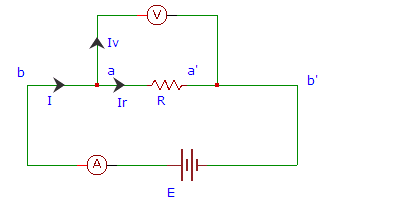1. How is the voltage drop across a low resistance related to lead resistance?
a) it contains contact resistance
b) it depends on the magnitude of voltage drop
c) it depends on the type of null detector used
d) It does not contain any contact resistance
Explanation: The voltage drop measured across a low resistance does not contain any contact and lead resistances of the components and is independent of it.
2. Which is not a source of error in the measurement of low resistance?
a) contact resistance drops at the leads
b) thermal e.m.f
c) temperature effect
d) power dissipation through the circuit
Explanation: As the current flowing through a low resistance circuit is low, the voltage drop across the terminals due to contact and lead resistances is negligible. Thermal e.m.f occurs in a circuit when its temperature increases due to high current flow.
3. Which is the most popular method for measuring low resistance?
a) ammeter-voltmeter method
b) potentiometer method
c) kelvin double bridge method
d) ducter ohmmeter method
Explanation: Kelvin’s double bridge is used for the measurement of low resistances of the order of 1ῼ or less. Ammeter voltmeter method is used for the measurement of current flowing through and the voltage across the circuit.
4. How is the contact resistance related to the circuit while measuring a low resistance?
a) independent of the type of resistance
b) it is negligible
c) depends on the e.m.f source
d) it is very high
Explanation: The contact and lead resistances form a part of the circuit whose resistance is very high. As a result the contact and lead resistances are usually neglected compared to the high resistance value.
5. Below figure, the terminals aa’ are used for _________
a) measuring the current flow through the circuit
b) measuring the power dissipation of the circuit
c) measuring the resistance of the circuit
d) measuring the voltage drop across the resistance
Explanation: The terminals aa’ are used for the measurement of the voltage drop across the resistance R. An voltmeter V is connected across the terminals aa’
6. In the following figure, what is the value of I?
a) I = IV + Ir
b) I = IV – Ir
c) I = IV Ir
d) I = IV ⁄ Ir
Explanation: By applying Kirchhoff’s current law at the node N from fig we get,
I = IV + Ir
where,
I is the total series current flowing through the circuit
Iv is the current flowing through the voltmeter
Ir is the current flowing through the resistance R.
7. Kelvin’s bridge consists of _________
a) double bridge
b) single bridge
c) half bridge
d) three fourth bridge
Explanation:Kelvin’s bridge consists of two additional arms compared to a Wheatstone bridge. Hence it is also known as a double bridge
8. The range of resistance measured in a Kelvin bridge is _________
a) 10Ω to 10 mΩ
b) 1Ω to 10 μΩ
c) 0.01Ω to 10 MΩ
d) 0.1Ω to 10 nΩ
Explanation: Kelvin bridge is used for the measurement of low resistances. Low resistances vary in the range of 1Ω to 10 μΩ
9. Accuracy of Kelvin bridge is of the order of _________
a) ±0.5 to ±2 %
b) ±0.05 to ±0.02 %
c) ±0.05 to ±0.2 %
d) ±0.005 to ±0.02 %
Explanation: As Kelvin bridge is used for the measurement of low resistance values, the accuracy of measurement of low resistances in a Kelvin bridge is of the order of ±0.05 to ±0.2 %.
10. What is the balance equation of Kelvin bridge?
a) Rx = \(\frac{R_2 R_3}{R_1}\)
b) Rx = \(\frac{R_1 R_2}{R_3}\)
c) Rx = \(\frac{R_1}{R_2}\)
d) Rx = \(\frac{R_1 R_3}{R_2}\)
Explanation: The balance equation in a Kelvin bridge is given by the relation Rx = \(\frac{R_1 R_3}{R_2}\)
where,
R1, R2, R3, and Rx form the ratio arms
Rx is the value of the unknown resistance.
